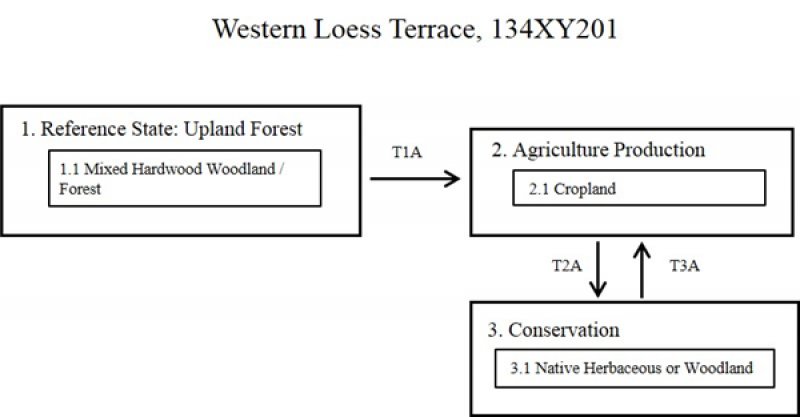
Natural Resources
Conservation Service
Ecological site F134XY201AL
Western Loess Terrace - PROVISIONAL
Last updated: 3/24/2025
Accessed: 12/22/2025
General information
Provisional. A provisional ecological site description has undergone quality control and quality assurance review. It contains a working state and transition model and enough information to identify the ecological site.
MLRA notes
Major Land Resource Area (MLRA): 134X–Southern Mississippi Valley Loess
The Southern Mississippi Valley Loess (MLRA 134) extends some 500 miles from the southern tip of Illinois to southern Louisiana. This MLRA occurs in Mississippi (39 percent), Tennessee (23 percent), Louisiana (15 percent), Arkansas (11 percent), Kentucky (9 percent), Missouri (2 percent), and Illinois (1 percent). It makes up about 26,520 square miles. Landscapes consist of highly dissected uplands, level to undulating plains, and broad terraces that are covered with a mantle of loess. Underlying the loess are Tertiary deposits of unconsolidated sand, silt, clay, gravel, and lignite. The soils, mainly Alfisols, formed in the loess mantle. Stream systems of the MLRA typically originate as low-gradient drainageways in the upper reaches that broaden rapidly downstream to wide, level floodplains with highly meandering channels. Alluvial soils, mostly Entisols and Inceptisols, are predominantly silty where loess thickness of the uplands are deepest but grade to loamy textures in watersheds covered by thin loess. Crowley’s Ridge, Macon Ridge, and Lafayette Loess Plains are discontinuous, erosional remnants that run north to south in southeastern Missouri - eastern Arkansas, northeastern Louisiana, and south-central Louisiana, respectively. Elevations range from around 100 feet on terraces in southern Louisiana to over 600 feet on uplands in western Kentucky. The steep, dissected uplands are mainly in hardwood forests while less sloping areas are used for crop, pasture, and forage production (USDA-NRCS, 2006).
This site occurs within a very small area on the oldest, loess-capped terraces of the Western Lowlands Pleistocene Valley Trains (EPA Level IV Ecoregion: 73g; Woods et al., 2004).
Classification relationships
All or portions of the geographic range of this site falls within a number of ecological/land classifications including:
-NRCS Major Land Resource Area (MLRA) 134 – Southern Mississippi Valley Loess
-NRCS Major Land Resource Area (MLRA) 131A – Southern Mississippi River Alluvium
-Environmental Protection Agency’s Level IV Ecoregion: Western Lowlands Pleistocene Valley Trains: 73g (Woods et al., 2004)
-234A – Southern Mississippi Alluvial Plain section of the USDA Forest Service Ecological Subregion (McNab et al., 2005)
-LANDFIRE Biophysical Setting 4515130 and NatureServe Ecological System CES203.193 Lower Mississippi River Flatwoods, respectively (LANDFIRE, 2008; NatureServe, 2009)
-Upland Forests of Pleistocene Outwash Terraces and Alluvial Fans (Klimas et al., 2012)
Ecological site concept
The Western Loess Terrace is characterized by deep, well drained soils that formed in a mantle of loess. The deep, loessal soils associated with this site were deposited mainly on the higher and older Pleistocene Valley Train terraces of the Western Lowlands. Slopes range from 0 to 8 percent and extend upwards to 12 percent, locally. Topographic features or landforms of this site include low mounds; narrow, linear ridges, and terrace scarps. These prominent positions on the flat terrace landscape never flood and are not influenced by seasonal wetness. Soils of this site have no root restrictions or limitations. Historically, the high grounds of this site were likely favored by indigenous people inhabiting the Western Lowlands, and their subsistence and cultural activities would have influenced the surrounding plant communities. Resultantly, a complex mosaic of conditions ranging from deep forest to open woodland to fire-maintained meadows likely existed. Today, this high, well-drained site is favored for construction and building purposes that include private residences, commercial lots, and cemeteries. Some areas remain under agriculture production but few, if any, locations support natural vegetation. The only instances that provide clues as to the natural vegetation of this site are old cemeteries and residential yards where large shade trees have been retained. The historic vegetation of this site likely consisted of species typical of diverse, mixed upland forests. Trees likely grew to large dimensions given the fertile soil – site environment. Species anticipated to respond well on this site include white oak, cherrybark oak, Shumard’s oak, black oak, southern red oak, hickory, elm, and ash.
Associated sites
| F134XY202AL |
Western Wet Loess Terrace - PROVISIONAL |
|---|---|
| F134XY206AL |
Western Fragipan Terrace - PROVISIONAL |
| F134XY209AL |
Western Moderately Wet Terrace - PROVISIONAL |
Similar sites
| F134XY007AL |
Northern Loess Terrace - PROVISIONAL This site is the eastern counterpart to the Western Loess Terrace site. |
|---|
Table 1. Dominant plant species
| Tree |
Not specified |
|---|---|
| Shrub |
Not specified |
| Herbaceous |
Not specified |
Click on box and path labels to scroll to the respective text.

